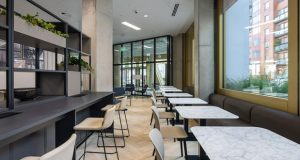INDOOR AIR QUALITY
Indoor air quality is largely dependent on outdoor air pollution. In addition, the indoor environment contains many sources of pollutants from building materials, consumer products, occupants and their activities.
In most countries, there is currently no comprehensive regulatory framework on indoor air quality (with the exception of radon), nor any widespread industry standard. Therefore, referring to WHO air quality guidelines alongside minimum regulatory requirements is recommended. There is a hierarchy of importance in the range of pollutants we are exposed to. Some pose a severe health and even death hazard through short-term exposure, such as carbon monoxide.
For some pollutants, long-term effects may show up years after exposure has occurred or after long or repeated periods of exposure – examples include radon, particulates and nitrogen dioxide. These long-term hazards may be respiratory or cardiovascular diseases. Other pollutants may not be a known severe health hazard, but become irritants if concentrations are sufficiently high or exposure sufficiently long, as with many volatile organic compounds (VOCs). Others may have limited health effects but are considered useful indicators of indoor air quality, such as carbon dioxide.
LIGHTING
Light is fundamental to our health, wellbeing, and cognitive capabilities. It acts through our visual environment, our circadian rhythms, and as radiation. In our visual environment, it is important to safety and visual comfort, supports task performance and communication, and complements architecture to create pleasing and beautiful environments. Negative visual impacts, such as eyestrain and the effects of glare and flicker, produce discomfort in the short term but can affect health if repeated over long periods, and can impact on safety.
Light also acts as a key regulator of our circadian rhythms, supporting sleep patterns, bodily functions, and emotional and mental wellbeing. It not only affects our health (it can help reduce the symptoms of depression and Alzheimer’s, for example) but also contributes to sleep disruption, with detrimental health consequences. In addition, light as radiation can have very serious health implications in terms of tissue damage to the eyes and skin.
 Both natural and electric lighting can contribute to design solutions. Daylight should be given priority wherever possible, complemented by glare protection. In temperate climates, a minimum average daylight factor of two per cent is recommended, and five per cent will usually be sufficient for a room to appear well daylit unless it is very deep or obstructed. Views out should be provided wherever possible, ideally including natural elements such as grass or trees.
Both natural and electric lighting can contribute to design solutions. Daylight should be given priority wherever possible, complemented by glare protection. In temperate climates, a minimum average daylight factor of two per cent is recommended, and five per cent will usually be sufficient for a room to appear well daylit unless it is very deep or obstructed. Views out should be provided wherever possible, ideally including natural elements such as grass or trees.
The final appearance of the lighting scheme will be greatly affected by the interior layout and finishes, requiring multidisciplinary coordination. Lighting products evolve rapidly, with many seeking to replicate natural daylight cycles, promoting alertness and cognitive performance during the day and avoiding sleep disruption at night. The claimed benefits should be carefully evaluated, particularly until such time as our understanding of ‘lighting for health’ is more advanced.
Indoor air quality and lighting are just two of the variables that affect health and wellbeing, but all the factors that influence the comfort of building occupants are undergoing debate, research and development. The complexity and interactions between factors in internal and external environments mean that a holistic approach is required – but the extra effort is worth it for healthier and happier people.
MAPPING OF WELLBEING STANDARDS
CIBSE has produced a tool mapping the WELL Building Standard requirements in the UK context in terms of WHO guidelines, CIBSE and Society of Light and Lighting guidance, British Standards, BREEAM and a selection of other key industry sources. The issues covered are air, water, light, comfort and mind. Currently only the air section is available, but the others will follow in due course. https://bit.ly/2Ou9lPC




